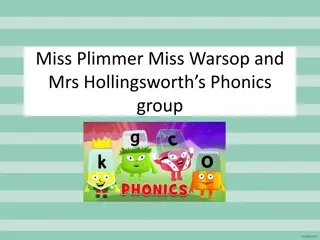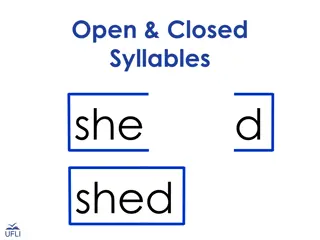Decoding English Words: From Syllables to Morphemes
Explore the evolution of English language complexity due to historical invasions, the impact on orthography, and the significance of morphophonemic patterns in decoding, spelling, and understanding English words using Latin and Greek morphemes.
Download Presentation

Please find below an Image/Link to download the presentation.
The content on the website is provided AS IS for your information and personal use only. It may not be sold, licensed, or shared on other websites without obtaining consent from the author.If you encounter any issues during the download, it is possible that the publisher has removed the file from their server.
You are allowed to download the files provided on this website for personal or commercial use, subject to the condition that they are used lawfully. All files are the property of their respective owners.
The content on the website is provided AS IS for your information and personal use only. It may not be sold, licensed, or shared on other websites without obtaining consent from the author.
E N D
Presentation Transcript
FROM SYLLABLES TO MORPHEMES Decoding/Spelling Vocabulary! Dr. Kathleen J. Brown: University of Utah Reading Clinic Sources: Unlocking Literacy (2003) by Marcia K. Henry Speech to Print (2000) by Louisa C. Moats
English = Complex--Thanks to Invasions! Original Celts Angles, Saxons & Jutes bring German Augustine brings Latin Vikings bring Danish Normans bring French Rennaisance brings Greek
Whos To Blame for Deep Orthography? Anglo-Saxon base words include 4,500 Old English words that have survived. - short, common words (e.g., hus, froend) Norman (French) invasion brought 8,000 new words (justice) & irregular spelling (e.g., niht night, queen cween)
So Whats the Big Deal? English is morphophonemic. It preserves spelling (to preserve meaning) even when phonemes change. sign -- signature melody melodic melodious image imagine know - knowledge
English Words: Decode, Spell, & Understand! Closed and open syllables account for 75% of English syllables. 12 Latin roots & 2 Greek forms provide clues to > 100,000 English words
Most Useful Latin & Greek Morphemes - LATIN - fer (to bear, to yield) - sist, sta, stat, stit (to stand) - fac, fact, fect, fic (to make, to do) - tend, tens, tent (to stretch, strain) - spec, spect, spic (to see, watch, observe) - pond, pose, pound (to put, place, set) - cap, ciet, ceive, cep, cept, cip (to take, seize, catch, receive, hold) - ten, tain, tin, tinu (to hold) - scrib, script (to write) - plic, ply (to fold) - duc, duce, duct (to lead) - mit, miss (to send) - GREEK - graph (written, drawn) - ology (study of)
English Words: Decode, Spell, & Understand! To decode, spell, and infer the meaning of BIG WORDS, kids need to know syllable patterns & morphemic patterns! Ergo, WE need know these patterns & become skilled at teaching them!
Syllable Patterns syllable = vowel and its surrounding(s) determine vowel sound unit of speech (larger than phoneme), not meaning 6 types: closed, open, v-e, r-controlled, vowel team, consonant-le Knowing 6 syllable types = tool for finding boundaries & applying vowel sounds in polysyllabic words. dis rup tive
Morpheme Patterns smallest units of meaning 4 types: base, root, affix, compound word bases, roots & affixes can be bound(-ion, struct, re-) or free (hope) dis rupt ive
What to Teach, When & to Who? Once kids can handle basic 1-2 syllable words and easy suffixes (e.g., helps, helping, returns, returned),begin morphology. Late 2nd Grade and on!
What to Teach, When & to Who? Curriculum: Start with Anglo-Saxon base words. Teach compound words. Then, most frequent affixes. Then, Latin roots with affixes. Then Greek. Instruction: 1. I do. We do. You do. 2. Kids need to talk it and write it at least 10 times accurately.
Compounds 2 base words together Each must be able to stand on its own. 2 morphemes (can also add A-S affixes) grandfather, flashlight, shellfish, railroad pretty easy stuff .
Anglo-Saxon Bases +Affixes Bases = free (can stand on own) 1 morpheme (sometimes 2) class, like, change, turn, friend, transmit Affixes = bound (cannot stand on own) 1 morpheme dis-, co-, re-, ex-, pre-, bi-, non-, trans
Concept Syllable Points swiftly
Concept Morpheme Points swiftly
Concept Syllable Points disinformation
Concept Morpheme Points disinformation
1st Encountered Prefix for A-S Base Words Prefix a- Meaning on, in; to A-S & Latin alike, around, awake, away Notice that the base is inflected leaving the prefix to take a schwa sound. This is very common! White, Sowell, & Yanagihara, 1989
Most Frequent Prefixes for A-S Base Words Prefix Meaning in- to, toward; not un- not, undo A-S or Latin mis- bad, wrong A-S or Latin dis- not (absence, apart) These 4 account for 58% of prefixed words in G3-G9 text. White, Sowell, & Yanagihara, 1989
Most Frequent Suffixes for A-S Base Words Suffix -s, -es, - ed, -ing Meaning number, tense, part of speech -ly, -er/or, -ion,-ible/able same as above 1st row accounts for 65% of suffixed words in G3-G9 text. 2nd row adds 17%. Do the math! White, Sowell, & Yanagihara, 1989
Be A Mind Reader! diagnostician circumstantial disinformation misanthropic assiduous irreconcilable
Reminders Model, model, model both process & language until they get it. Baby steps, then increase challenge! Use consistent prompts (tell them location & action). Ask them to pair share after each step.























